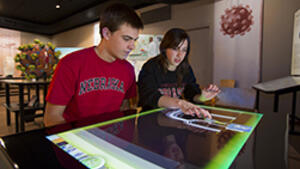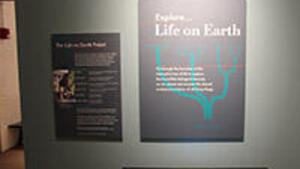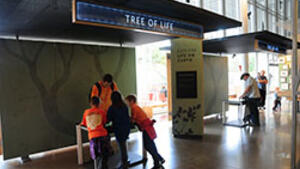Florian Block, James Hammerman, Michael Horn, Amy Spiegel, Jonathan Christiansen, Brenda Phillips, Judy Diamond, Margaret Evans, and Chia Shen. 4/18/2015. “
(Best Paper Award) Fluid Grouping: Quantifying Group Engagement around Interactive Tabletop Exhibits in the Wild.” In Proceedings of the 2015 ACM annual conference on Human Factors in Computing Systems (CHI'15). New York, NY, USA.
Publisher's VersionAbstract
Interactive surfaces are increasingly common in museums and other informal learning environments where they are seen as a medium for promoting social engagement. However, despite their increasing prevalence, we know very little about factors that contribute to collaboration and learning around interactive surfaces. In this paper we present analyses of visitor engagement around several multi-touch tabletop science exhibits. Observations of 629 visitors were collected through two widely used techniques: video study and shadowing. We make four contributions: 1) we present an algorithm for identifying groups within a dynamic flow of visitors through an exhibit hall; 2) we present measures of group-level engagement along with methods for statistically analyzing these measures; 3) we assess the effect of observational techniques on visitors' engagement, demonstrating that consented video studies do not necessarily reflect visitor behavior in more naturalistic circumstances; and 4) we present an analysis showing that groups of two, groups with both children and adults, and groups that take turns spend longer at the exhibits and engage more with scientific concepts.
 Fluid Grouping: Quantifying Group Engagement around Interactive Tabletop Exhibits in the Wild
Fluid Grouping: Quantifying Group Engagement around Interactive Tabletop Exhibits in the Wild Michael Horn, Brenda Phillips, Margaret Evans, Florian Block, Judy Diamond, and Chia Shen. 4/11/2015. “
Visualizing the tree of life: Learning around an interactive visualization of biological data in museums.” In NARST Annual International Conference (NARST 2015). Hyatt Regency Chicago 151 East Wacker Drive Chicago, IL 60601.
AbstractA central goal of many science museums is to provide hands-on experiences in which visitors learn from exhibit elements and through their interactions with other visitors (Falk & Dierking, 2000; Allen, 2004; Humphrey & Gutwill, 2005; Oppenheimer, 1978). These types of experiences are often characterized by physical engagement with scientific phenomena, open-ended exploration, and carefully designed support for collaboration. However, there are many types of experiences that museums might want to offer in this spirit that go beyond the direct manipulation of physical phenomena (Meisner et al., 2007; Louw & Crowley, 2013). In particular, advances in interactive computer displays coupled with new information visualization techniques have made it possible to offer hands-on experiences in which visitors “touch” and explore large scientific datasets (e.g. Louw & Crowley, 2013; Ma et al., 2012; Roberts et al., 2014; Hinrichs, Schmidt, & Carpendale, 2008). Such exhibits create new opportunities for visitors to engage with authentic computational tools (Louw & Crowley, 2013) while at the same time reflecting the evolving nature of scientific inquiry (Henderson, Cortina, & Wing, 2007). Despite these advantages, however, we know little about how such exhibits support learning.
 Visualizing the tree of life: Learning around an interactive visualization of biological data in museums
Visualizing the tree of life: Learning around an interactive visualization of biological data in museums Pryce Davis, Michael Stephen Horn, Florian Block, Brenda Phillips, Margaret Evans, Judy Diamond, and Chia Shen. 3/4/2015. “
"Whoa! We’re going deep in the trees!": Patterns of collaboration around an interactive information visualization exhibit.” International Journal of Computer-Supported Collaborative Learning, 10, Pp. 53–76.
Publisher's VersionAbstract
In this paper we present a qualitative analysis of natural history museum visitor interaction around a multi-touch tabletop exhibit called DeepTree that we designed around concepts of evolution and common descent. DeepTree combines several large scientific datasets and an innovative visualization technique to display a phylogenetic tree of life consisting of over 70,000 species. After describing our design, we present a study involving pairs of children interacting with DeepTree in two natural history museums. Our analysis focuses on two questions. First, how do dyads negotiate their moment-to-moment exploration of the exhibit? Second, how do dyads develop and negotiate their understanding of evolutionary concepts? In order to address these questions we present an analytical framework that describes dyads’ exploration along two dimensions: coordination and target of action. This framework reveals four distinct patterns of interaction, which, we argue, are relevant for similar interactive designs. We conclude with a discussion of the role of design in helping visitors make sense of interactive experiences involving the visualization of large scientific datasets.
 "Whoa! We’re going deep in the trees!": Patterns of collaboration around an interactive information visualization exhibit
"Whoa! We’re going deep in the trees!": Patterns of collaboration around an interactive information visualization exhibit 




















